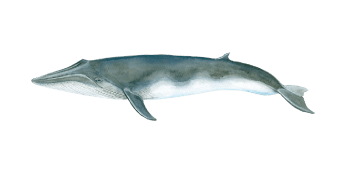
Bryde’s whale
(Balaenoptera edeni)
Bryde’s whales are baleen whales and belong to the family of rorquals. Instead of teeth, baleen whales have baleen aligning their upper jaws that work as a filtering system. Baleen consists of plates made of keratin that grow from the upper jaw down into the oral cavity. On the inside, the baleen plates are frayed and act much like a sieve.
As opposed to toothed whales, baleen whales have two blowholes and do not possess an echolocation system. Rorquals are known for a peculiar feature within the group of baleen whales; they have a large number of longitudinal furrows (folds of skin) on their throats which enable it to expand when the whales swallow large amounts of water during feeding.
Rorquals feed on zooplankton and small fish and consequently migrate to designated feeding areas where their prey exists in abundance.
General information
Further names: Portuguese: Baleia-de-Bryde ;English: Tropical whale
Size of adults: Females 12 to 16 m (grow larger than males). Newborn animals already measure 3-4m.
Prey: In the waters around Madeira they mainly feed on small schooling fish, squid, krill and other planktonic crustaceans. Bryde whales are lunge feeders, accelerating at their prey with their mouth wide open to catch as much prey as they can in one gulp. Using their tongue, they force the water out of their mouths on the sides, filtering out small fish and crustaceans on their baleen in the process.
Behaviour: Very little is known about the behaviour of these whales. They can often be encountered in groups of two to six. Often display curious behaviour and seen feeding alongside other cetaceans.
Range: Occur solely in tropical, sub-tropical latitudes. Unlike other baleen whales, they do not migrate or only do so over short distances.
Madeira: Can occur all year round but seen much more frequently in summer, with most encounters involving solitary animals or mothers with calves. Occasionally seen associating with Sei whales.
Distinctive features: Only rorqual with three parallel ridges extending from the blowhole to the tip of their snout. Apart from this distinctive feature, they can also be identified through their tall, narrow spout. They have a small, falcate dorsal fin and a slender, torpedo-shaped body which can reach speeds of up to 20 kmh. Easily mistaken for Sei whales at sea.
Taxonomy: Suborder: Mysticeti (Baleen whales); Family: Balaenopteridae (Rorquals)
Threats: Insufficient on global population size. They are threatened by potential boat collisions and possible entanglement in free-floating fishing nets. The increasing noise pollution in our oceans also affects the long range communication amongst the animals.
